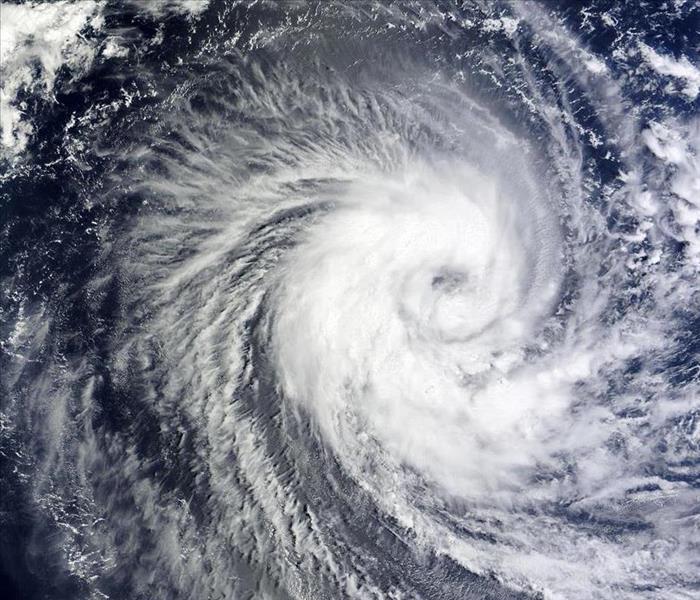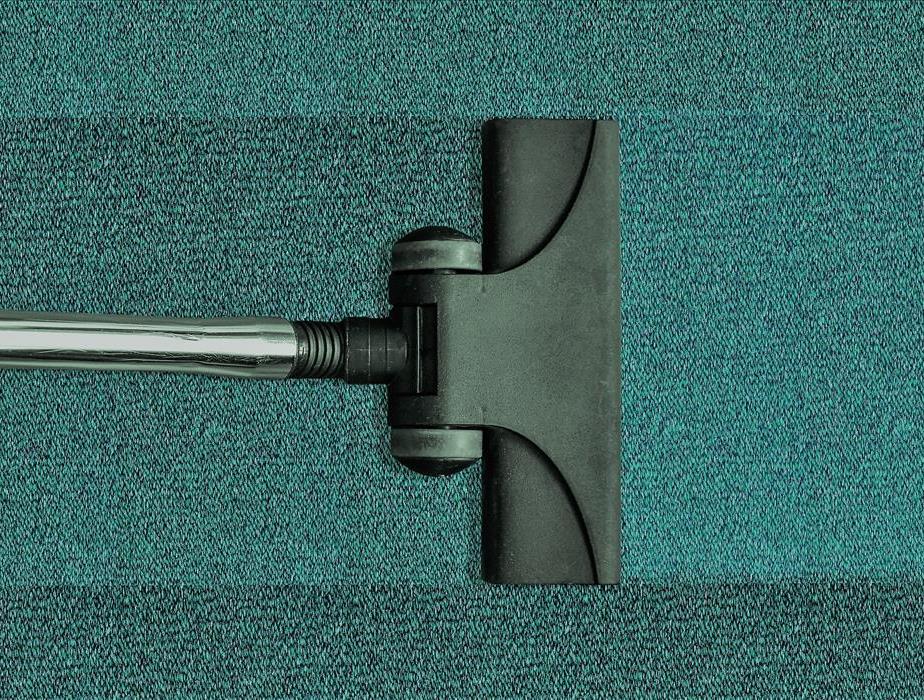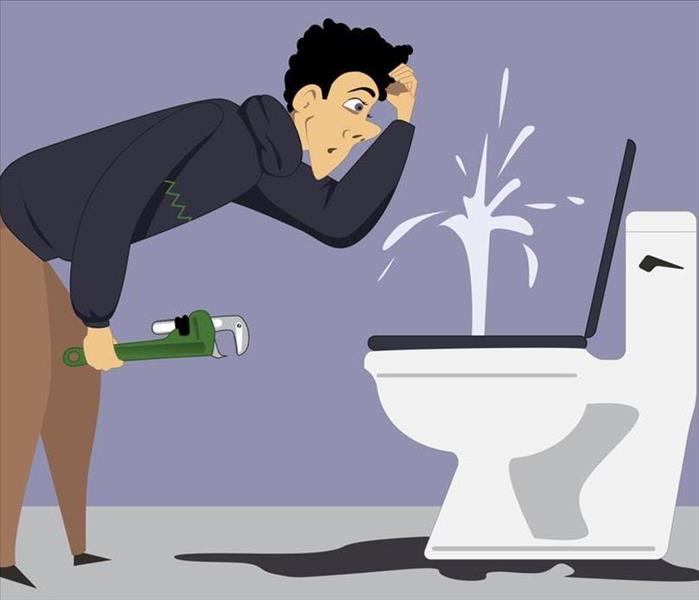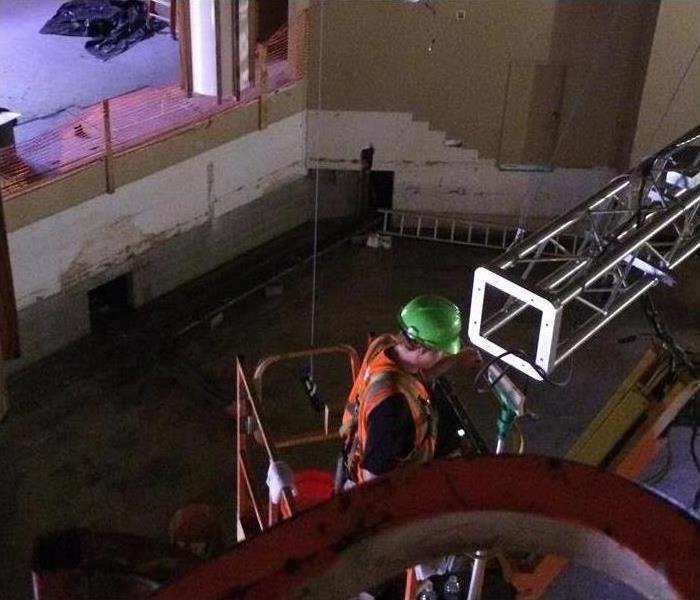Recent Posts
September 10th--Peak Hurricane Season
9/12/2024 (Permalink)
The peak of the Atlantic hurricane season is September 10th, with most activity occurring between mid-August and mid-October, according to the National Oceanic and Atmospheric Administration.
According to the NOAA, the exact day of September 10th is the day you are mostly likely to find a tropical cyclone somewhere in the Atlantic, statistically speaking. This year, the peak of Hurricane Season coincided with Hurricane Francine in the Gulf of Mexico.
Do not wait to prepare yourself for a hurricane when a storm forms in the Atlantic and stores are filling with shoppers looking for emergency supplies.
There are steps that you can take now to ensure you and your household are more prepared for the peak hurricane season:
- Build a survival kit. You and your household should be prepared to shelter in a secure and safe location for several days after a disaster when roads may be impassable, gas stations and grocery stores closed, power and communications being out. Common items are water—drinking and sanitation, food, medication, first aid kit and hygiene products.
- Make a Family Communication Plan. Choose an out-of-town friend or relative as a point of contact. Make sure children have emergency contacts memorized or saved in a secure place. Determine a safe, familiar place the family can go to reunite.
- Stay Informed. Listen to local officials for the most up-to-date information before, during and after a disaster. Keeping a battery or solar-powered radio to receive disaster notices and updates in your survival kit is key.
2024 Hurricane Season
5/24/2024 (Permalink)
NOAA National Weather Service forecasters are predicting an above-normal hurricane activity this year. The 2024 Hurricane Season spans from June 1st to November 30th. NOAA is forecasting a range of 17-25 total named storms (winds of 39 mph or higher). Out of those, 8-13 are forecast to become hurricanes with winds of 74 mph or higher and that includes 4 to 7 major hurricanes (cat 3, 4, 5).
FEMA in accordance with NOAA is recommending going ahead and preparing because severe weather and emergencies can happen at any moment. Taking a proactive approach today can make a difference in how quickly people can recover tomorrow.
NOAA is taking multiple steps to ensure better communications for the 2024 season.
- NOAA is implementing improvements to its forecast communications, decision support and storm recovery efforts this season.
- They are using new tools for hurricane analysis and forecasting.
- Upgrades to NOAA observing systems that are critical in understanding and forecasting hurricanes.
For more information on the 2024 hurricane season, visit www.noaa.gov.
Smoke Alarm Installation
5/20/2024 (Permalink)
Smoke Alarms
It’s important to install your smoke alarms correctly and make sure they are in working order. Fire research has indicated that with today’s modern furnishing, fires can spread much more rapidly than in the past when more natural materials were used. This is why having enough properly located smoke alarms is so important.
Installing smoke alarms:
- Install smoke alarms inside each bedroom, outside each sleeping area and on every level of the home.
- Smoke alarms should be installed at least 10ft from a cooking appliance to minimize false alarms when cooking.
- Smoke rises. It is important to mount smoke alarms high on walls or ceilings to ensure they are functioning properly.
- Don’t install smoke alarms near windows, doors, or ducts where drafts may interfere with their operation.
- Keep manufacturer’s instructions for reference.
Testing smoke alarms:
- Smoke alarms should be maintained according to manufacturer's instructions.
- Test smoke alarms at least once a month using the test button.
- Smoke alarms with non-replaceable 10-year batteries are designed to remain effective for up to 10 years. If the alarm chirps, it is a warning that the battery is low and needing to be replaced.
- Smoke alarms with disposable batteries should be replaced once a year. If the alarm chirps, it is a warning that the battery is low and needing to be replaced.
Prepare Now for the Peak of Hurricane Season
8/28/2023 (Permalink)
The peak of the Atlantic hurricane season is September 10th, with most activity occurring between mid-August and mid-October, according to the National Oceanic and Atmospheric Administration. Do not wait to prepare yourself for a hurricane when a storm forms in the Atlantic and stores are filling with shoppers looking for emergency supplies.
There are steps that you can take now to ensure you and your household are more prepared for the peak hurricane season:
- Build a survival kit. You and your household should be prepared to shelter in a secure and safe location for several days after a disaster when roads may be impassable, gas stations and grocery stores closed, power and communications being out. Common items are water—drinking and sanitation, food, medication, first aid kit and hygiene products.
- Make a Family Communication Plan. Choose an out-of-town friend or relative as a point of contact. Make sure children have emergency contacts memorized or saved in a secure place. Determine a safe, familiar place the family can go to reunite.
- Stay Informed. Listen to local officials for the most up-to-date information before, during and after a disaster. Keeping a battery or solar-powered radio to receive disaster notices and updates in your survival kit is key.
NOAA on 2023 Hurricane Season
5/22/2023 (Permalink)
 2023 Hurricane Season begins June 1st.
2023 Hurricane Season begins June 1st.
The National Oceanic and Atmospheric Administration is scheduled to issue its outlook for the 2023 Atlantic Hurricane season. The NOAA will discuss the expected number of storms and climate factors that will influence hurricane development. They will also provide advice on how to prepare for the upcoming hurricane season which officially begins on June 1st. The NOAA will also discuss their readiness for the season showcasing new products and upgrades to enhance forecasting and operations.
Hurricane names for the 2023 season have been released. There are new names in the rotation that will replace Harvey, Irma, Maria, and Nate. Those names will be replaced with Harold, Idalia, Margot, and Nigel.
Don’t forget to tune in on Thursday, May 25 to hear all about the 2023 Atlantic Hurricane Season!
Fire Safety Facts
5/18/2023 (Permalink)
 Smoke detectors can help keep you safe in the event of a fire.
Smoke detectors can help keep you safe in the event of a fire.
Fire safety comes in many forms. Here are some facts that can provide some insight into fire safety.
- A closed door may slow the spread of smoke, heat, and fire.
- Smoke alarms should be installed inside every sleeping room, outside of each sleeping area, and on every level. Smoke alarms should be connected so when one sounds, they all sound.
- Roughly, three out of five fire deaths happen in homes with no smoke alarms or no working smoke alarms.
- Fires most often start in the kitchen. Almost 30 percent of fires start in the kitchen because this is primarily where open flames are used.
- Cooking and heating cause the most fires.
If a fire occurs in your home, GET OUT, STAY OUT and CALL FOR HELP. Never go back inside for anything or anyone.
Commercial Cleaning Services
5/18/2023 (Permalink)
 SERVPRO can help make your workspace clean.
SERVPRO can help make your workspace clean.
With SERVPRO’s commercial cleaning services, you won’t have to worry about the common wear and tear of your buildings or offices. When grit/grime, moisture, and odor overwhelm a standard janitorial service, call SERVPRO of Beaumont. You can rely on us to make your workspace the cleanest it’s ever been.
SERVPRO of Beaumont will get it done right the first time with our:
- Award-Winning Training
- Nearly 50 Years of Experience
- Proprietary Cleaning Products
Specialty Cleaning Services
SERVPRO offers a broad scope of cleaning services - from bloodborne pathogens to mold to fire/water restoration. Our technicians have specialized training and products to effectively clean your business and make it "Like it never even happened." We can do it all:
- Air ducts & HVAC
- Biohazard and Crime Scene
- Carpet & Upholstery
- Odor Removal
Sewage - Trauma and Crime Scene
And much more - Call us today at 409-212-1977!
3 Ways to Protect Your Home During a Flood
12/5/2022 (Permalink)
 FEMA will assist with recovery and rebuilding efforts, there are things that you can do before and after a flood to help protect your property.
FEMA will assist with recovery and rebuilding efforts, there are things that you can do before and after a flood to help protect your property.
3 Ways to Protect Your Home During a Flood
Floods can happen at any time, and it's important to be prepared for them. If you live in an area that's prone to flooding, there are a few things you can do before a flood strikes so that you're ready when it does.
Seal any cracks in your home’s foundation.
After you've assessed the damage, it's time to patch the cracks in your foundation. You'll need a waterproof sealant like caulking or silicone sealant for this job. If you have silicone-based paint, use that instead of a separate caulking product because it can also be used as an adhesive for other materials like wood and metal.
First, apply the sealant to both sides of the crack, then smooth out any excess with a putty knife. Make sure you get all around the edges so there aren't any gaps where water could eventually seep through and damage your home again.
Maintain drainage areas.
- Maintain drainage areas
- Grass should be trimmed short to avoid clogging gutters, and trees and shrubs should be trimmed to ensure that water flows away from the house.
- Make sure your gutters are clean and free of debris.
- Keep downspouts clear of leaves and other debris so water can drain properly into the ground rather than pooling around your foundation or flowing toward your basement.
- Clean out rain barrels, which collect rainwater that then drains into soil rather than running off toward storm drains or sewers (and possibly flooding).
Install a sump pump.
If your home is in a flood zone, you should consider installing a sump pump. Sump pumps are used to remove excess water from the lowest part of your basement or crawl space and safely discharge it away from the house. You can also find sump pumps that feature battery backup units (BBUs) and remote monitoring technologies—these will allow homeowners to check on their sump pump remotely in case there's ever a problem with it.
If you live near a body of water or have experienced flooding at some point, consider installing this essential piece of equipment today!
Know what to do before, during, and after a flood.
The best way to protect your home is to be prepared. While the Federal Emergency Management Agency (FEMA) will assist with recovery and rebuilding efforts, there are things that you can do before and after a flood to help protect your property. Flood insurance differs from homeowner's insurance in several ways, so it's important to know the difference. It's also helpful to know what actions you should take before, during and after a flood occurs so that you can prepare accordingly:
Before a flood happens:
- Make sure all your homeowners' contents are insured—this includes appliances, electronics, furniture and clothes. You may have additional coverage from certain policies or other types of insurance (such as renters or car insurance).
We all want to protect our Amelia, TX homes, and there are many things you can do to do just that. As with any disaster, it's best to be prepared before it happens. But if you are still unsure about how best to prepare for a flood or other natural disaster, it's always good to know where your local emergency management office is located so that they can help answer any questions or concerns.
How Do I Replace A Toilet?
11/1/2022 (Permalink)
 If you think your toilet is leaking or not working as well as it should, replace it.
If you think your toilet is leaking or not working as well as it should, replace it.
How Do I Replace A Toilet?
Replacing a toilet can seem like an overwhelming task, but it's not. The average DIYer can typically complete this project in about six hours. Here are the step-by-step instructions for replacing a toilet:
Cut the water supply, flush toilet, and sponge all remaining water from tank and bowl.
- Cut the water supply to the toilet, then flush it to drain any remaining water.
- If you have a frost-free refrigerator or freezer, turn off its power switch and remove all food from inside (this will help prevent damage).
- Unscrew any mounting bolts that are holding the hot water tank in place and lift it out of its housing; don't worry if some piping comes with it because you can reattach these later.
Disconnect hose leading to bottom of tank.
Now that the tank is out of the bowl, you can disconnect the hose leading to the bottom of the tank. You may have to loosen or unscrew a clamp holding it in place before pulling it free. The water supply should now be disconnected from your toilet.
To lift out your old toilet, shift your weight slightly toward one side and lift it straight up until you can set it aside.
Unscrew the nuts that connect the tank to the bowl, remove tank and set aside.
- Unscrew the nuts that connect the tank to the bowl, remove tank and set aside
- Remove any remaining water from inside the toilet bowl with a sponge or towel
- Remove old wax ring from underneath where you will replace it (usually a square piece of plastic).
Remove nuts that hold bowl to floor, lift straight up on bowl and set aside.
To replace the toilet, you'll need to remove the nuts and washers that hold the bowl to its base. To do this:
- Remove the nuts on each side of your toilet using socket set or wrench.
- Lift straight up on the bowl and set it aside.
Remove any wax ring or putty that remain around drain collar on floor.
- Remove any wax ring or putty that remain around drain collar on floor.
- Use a putty knife to scrape off any old putty, if there is any.
- Clean the area around the drain collar with a sponge and mild detergent, then use dry paper towels to dry it thoroughly.
Install new wax ring onto new toilet base.
- Place the new toilet base on wax ring.
- Press down firmly so that it adheres to the wax ring (no rocking). Ensure a tight connection between toilet base and wax ring. If you have a leak, tighten the connection between the toilet base and wax ring by adding more plumber's putty or tightening with adjustable wrench as needed.
Set new toilet in place and press down firmly so that it adheres to the wax ring (no rocking).
Once the new toilet is in place, you must press down firmly to ensure that it is properly seated on the floor. If you see any rocking motion, then there may be an issue with the wax ring, and you should check for leaks before proceeding further.
If no leaks are present and your toilet is not leaking after pressing down firmly on it, then proceed to connect water supply lines and test operation of the new toilet.
Reattach the new and old water line, ensuring a tight connection.
To reattach the new and old water line, ensure that the water supply is turned off. Then, make sure that your new toilet is level with your old one and secure. The last thing you want is for it to start shifting around on you during installation. If need be, use a wrench to tighten the bolts so they're nice and tight.
Replace your toilet if you think it is leaking or not working well — but if leaks persist call a professional plumber
If you think your toilet is leaking or not working as well as it should, replace it. But if you are not sure and want to check if there is a leak, first check the water level in your tank. If the water level is lower than normal, check for leaks at the base of the toilet by submerging a towel under it and checking on both sides; look for wet spots under the tank lid and base.
If you think there may be a leak but are unsure how to fix it yourself (or hire someone to do so), here's how to replace a toilet:
- Turn off the power source or flush handle/valve assembly that serves as an access point for stopping wastewater flow from pipes leading from your home’s plumbing system
- Unscrew bolts holding down flange between bowl unit and floor with socket wrench; remove flange from bowl unit
You can replace your toilet and save money. The first step is to turn off the water supply, disconnect the old tank and bowl, remove the old wax ring, and set aside. Then, install a new wax ring onto the base of your new toilet (not into floor). Finally, set it in place and press down firmly so that it adheres to the wax ring (no rocking). Reattach old water line to new toilet base ensuring a tight connection before turning on water supply once again!
How do I protect my business from fire disaster?
10/19/2022 (Permalink)
 Church fire in the Beaumont area.
Church fire in the Beaumont area.
How Can I Protect My Company From A Fire?
Fires in a business can be devastating and cause significant damage. Fires in the workplace can be particularly damaging for several reasons. For one thing, most businesses are not prepared for a fire disaster. They may not have fire extinguishers or alarms set up properly. You need to anticipate any potential dangers that could lead to fire hazards within your workspace so that you can be prepared when something does happen. Here are some tips on protecting your business from fire disasters:
Planning Ahead for a Fire
First and foremost, it’s important to be prepared for a fire. You need to make sure you have a plan for your employees, as well as for how your business might be impacted during an evacuation and after the fact.
If you’re in the Beaumont, TX area, we recommend calling our office immediately if you ever suspect that your property is at risk of being damaged by fire or smoke. Our team has experience handling these situations on a regular basis, so let us help guide you through this process to minimize any damage done to your business!
Your Fire Plan
- Have a fire escape plan:
- Check your smoke alarms at least once a month and change the batteries when you do.
- Keep all combustible materials (paper, cardboard, etc.) away from heat sources like stoves and heaters.
- If you have others in your home or workplace, make sure they're familiar with the route out of the building in case of an emergency.
Inspecting Equipment Regularly
You can have regular inspections of your equipment and wiring to reduce the risk of a fire.
- Make sure that your fire extinguisher is in good condition, and that you know how to use it.
- Ensure that your equipment is well maintained, so it doesn’t cause an electrical fire or spark a grease fire in the kitchen.
- Test smoke detectors regularly, and replace batteries as needed.
Protecting Yourself, Others, and Your Space
Fire prevention and protection are not just a matter of good business sense. They're also a legal requirement in some areas. If you don't have a planned fire safety policy in place, you could find yourself liable for damage caused by an uncontrolled fire in your building.
To avoid expensive lawsuits and fines, follow these tips:
- Make sure that all employees are trained on how to use the fire alarm system and what exits to take when the alarm sounds
- Have regular inspections conducted by a qualified professional (such as an electrician) to ensure that wiring is up-to-code, appliances are installed correctly and safely maintained, etc.
- Install smoke detectors throughout your building
Conclusion
All in all, it’s important to remember that fire prevention is not something that you can do once and then forget about. It’s a constant process of looking for ways to improve your business so that it’s as safe from fires as possible. The tips we’ve given here are just some of the many ways you can do this—and they should be at the top of your list if you want to protect yourself from fire disaster!




 24/7 Emergency Service
24/7 Emergency Service





